Engage NY Eureka Math Geometry Module 3 Lesson 11 Answer Key
Eureka Math Geometry Module 3 Lesson 11 Exercise Answer Key
Exercise 1.
A cone fits inside a cylinder so that their bases are the same and their heights are the same, as shown in the diagram below. Calculate the volume that Is inside the cylinder but outside of the cone. Give an exact answer.

Answer:
The volume of the cylinder is V = 52π(12) = 300π.
The volume of the cone is V = \(\frac{1}{3}\) 52π(12) = 100π.
The volume of the space that is inside the cylinder but outside the cone is 200π.
Alternative solution:
The space between the cylinder and cone is equal to \(\frac{2}{3}\) the volume of the cylinder. Then, the volume of the space is
V = 52π(12) = 200π.
Exercise 2.
A square pyramid has a volume of 245 in3. The height of the pyramid is 15 in. What is the area of the base of the pyramid? What is the length of one side of the base?
Answer:
V = \(\frac{1}{3}\) (area of base)(height)
245 = \(\frac{1}{3}\) (area of base)(15)
245 = 5(area of base)
49 = area of base
The area of the base is 49 in2, and the length of one side of the base is 7 in.
Exercise 3.
Use the diagram below to answer the questions that follow.

a. Determine the volume of the cone shown below. Give an exact answer.
Answer:
Let the length of the radius be r.
112 + r2 = (√137)2
r2 = (√137)2 – 112
r2 = 16
r = 4
The volume of the cone is V = \(\frac{1}{3}\)42π(11) = \(\frac{176}{3}\)π.
b. Find the dimensions of a cone that is similar to the one given above. Explain how you found your answers.
Answer:
Student answers vary. A possible student answer:
A cone with height 33 and radius 12 is similar to the one given because their corresponding sides are equal in ratio, that is, 11:33 and 4:12. Therefore, there exists a similarity transformation that would map one cone onto the other.
c. Calculate the volume of the cone that you described in part (b) in two ways. (Hint: Use the volume formula and the scaling principle for volume.)
Answer:
Solution based on the dimensions provided in possible student response from part (b).
Using the volume formula:
V = \(\frac{1}{3}\)122π(33)
V = 1584π
For two similar solids, if the ratio of corresponding sides is a: b, then the ratio of their volumes is a3: b3. The corresponding sides are in ratio 1: 3, so their volumes will be in the ratio 13 : 33 = 1:27. Therefore, the volume of the cone in part (b) is 27 times larger than the given one:
V = 27(\(\frac{176}{3}\)π)
V = 1584π.
Exercise 4.
Gold has a density of 19.32 g/cm3. If a square pyramid has a base edge length of 5 cm, a height of 6 cm, and a mass of 942 g, Is the pyramid in fact solid gold? If It is not, what reasons could explain why it is not? Recall that density can be calculated with the formula density = \(\frac{\text { mass }}{\text { volume }}\).
Answer:
V = \(\frac{1}{3}\)(52)(6)
V = 50
The volume of the pyramid is 50 g.
density(pyramid) = \(\frac{942}{50}\) = 18.84
Since the density of the pyramid is not 19.32 g/cm3, the pyramid is not solid gold. This could be because part of it is hollow, or there is a mixture of metals that make up the pyramid.
Eureka Math Geometry Module 3 Lesson 11 Problem Set Answer Key
Question 1.
What is the volume formula for a right circular cone with radius r and height h?
Answer:
Area = Bh = \(\frac{1}{3}\)(πr2)h
Question 2.
Identify the solid shown, and find its volume.

Answer:
The solid is a triangular pyramid.
Volume = \(\frac{1}{3}\)Bh
Volume = \(\frac{1}{3}\)(\(\frac{1}{2}\) · 3 · 6) · 4
Volume = 12
The volume of the triangular pyramid is 12 unit3.
Question 3.
Find the volume of the right rectangular pyramid shown.
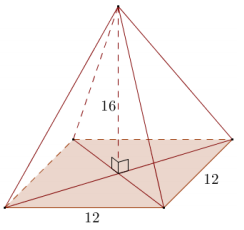
Answer:
Volume = \(\frac{1}{3}\)Bh
Volume = \(\frac{1}{3}\)(12 · 12) · 6
Volume = 768
The volume of the right rectangular pyramid is 768 unit3.
Question 4.
Find the volume of the circular cone in the diagram. (Use \(\frac{22}{7}\) as an approximation of pi.)

Answer:
Volume = \(\frac{1}{3}\)Bh
Volume = \(\frac{1}{3}\)(π · r2)h
Volume = \(\frac{1}{3}\)(\(\frac{22}{7}\) · 142) · 27
Volume = \(\frac{1}{3}\)(616) · 27
Volume = 5544
The volume of the circular cone is, 544 unit3.
Question 5.
Find the volume of a pyramid whose base is a square with edge length 3 and whose height is also 3.
Answer:
Volume = \(\frac{1}{3}\)Bh
Volume = \(\frac{1}{3}\)(32) · 3 = 9
The volume of pyramid is 9 units3.
Question 6.
Suppose you fill a conical paper cup with a height of 6” with water. If all the water is then poured into a cylindrical cup with the same radius and same height as the conical paper cup, to what height will the water reach in the cylindrical cup?
Answer:
A height of 2”
Question 7.
Sand falls from a conveyor belt and forms a pile on a flat surface. The diameter of the pile is approximately 10 ft., and the height is approximately 6 ft. Estimate the volume of the pile of sand. State your assumptions used In modeling.
Answer:
Assuming that the pile of sand is shaped like a cone, the radius of the pile would be 5 ft., and so the volume of the pile in cubic feet would be \(\frac{1}{3}\)π52 · 6 or approximately 157.
Question 8.
A pyramid has volume 24 and height 6. Find the area of its base.
Answer:
Let A be the area of the base.
Volume = \(\frac{1}{3}\)Bh
24 = \(\frac{1}{3}\)A · 6
A = 12
The area of the base is 12 units2.
Question 9.
Two jars of peanut butter by the same brand are sold in a grocery store. The first jar is twice the height of the second jar, but its diameter is one-half as much as the shorter jar. The taller jar costs $1.49, and the shorter jar costs $2.95. Which jar is the better buy?
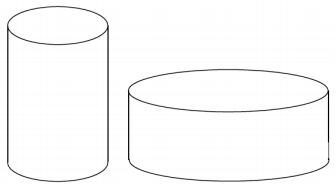
Answer:
The shorter jar is the better buy because it has twice the volume of the taller jar and costs five cents less than twice the cost of the taller jar.
Question 10.
A cone with base area A and height h is sliced by planes parallel to its base into three pieces of equal height. Find the volume of each section.
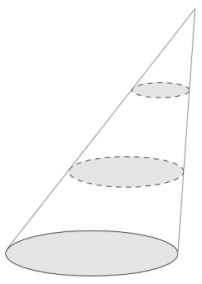
Answer:
The top section is similar to the whole cone with scale factor \(\frac{1}{3}\), so its volume is

The middle section has volume equal to the difference of the volume of the top two-thirds of the cone and the top one-third of the cone.
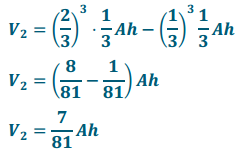
The bottom section has volume equal to the difference of the volume of the entire cone and the volume of the top two-thirds of the cone.

Question 11.
The frustum of a pyramid is formed by cutting off the top part by a plane parallel to the base. The base of the pyramid and the cross-section where the cut is made are called the bases of the frustum. The distance between the planes containing the bases is called the height of the frustum. Find the volume of a frustum if the bases are squares of edge lengths 2 and 3, and the height of the frustum is 4.
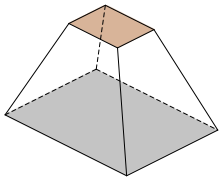
Answer:
Let V be the vertex of the pyramid and h the height of the pyramid with base the
smaller square of edge length 2. Then, h + 4 is the height the pyramid. The smaller square is similar to the larger square with scale factor \(\frac{2}{3}\), but the scale factor is also \(\frac{h}{h+4}\). Solving \(\frac{h}{h+4}\) = \(\frac{2}{3}\) gives h = 8. So, the volume of the pyramid whose base is the square of edge length 3 and height of (8) + 4, or 12, is \(\frac{1}{3}\) 32 · 12 or 36. The volume of the pyramid with base the square of edge length 2 and height 8 is \(\frac{2}{3}\)22 · 8 or 10\(\frac{1}{3}\). The volume of the frustum is 36 – 10\(\frac{2}{3}\) or 25\(\frac{1}{3}\). The volume of the frustum is 25\(\frac{1}{3}\) units3.
Question 12.
A bulk tank contains a heavy grade of oil that is to be emptied from a valve into smaller 5. 2-quart containers via a funnel. To improve the efficiency of this transfer process, Jason wants to know the greatest rate of oil flow that he can use so that the container and funnel do not overflow. The funnel consists of a cone that empties into a circular cylinder with the dimensions as shown in the diagram. Answer each question below to help Jason determine a solution to his problem.
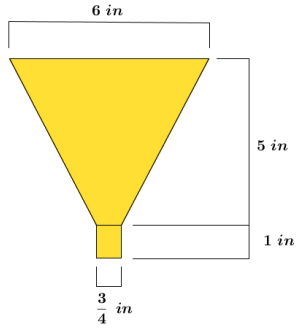
Answer:
a. Find the volume of the funnel.
Answer:
The upper part of the funnel is a frustum, and its volume is the difference of the complete cone minus the missing portion of the cone below the frustum. The height of the entire cone is unknown; however, it can be found using similarity and scale factor. Let x represent the unknown height of the cone between the frustum and the vertex. Then, the height of the larger cone is 5 + x.
Using corresponding diameters and heights:
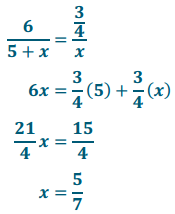
The height of the cone between the frustum and the vertex is \(\frac{5}{7}\) in., and the total height of the cone including the frustum is 5\(\frac{5}{7}\) in.
The volume of the frustum is the difference of the volumes of the total cone and the smaller cone between the frustum and the vertex.
Let VT represent the volume of the total cone in cubic inches, Vs represent the volume of the smaller cone between the frustum and the vertex in cubic inches, and VF represent the volume of the frustum in cubic inches.
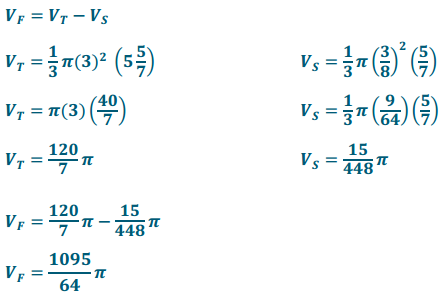
Let VC represent the volume of the circular cylinder at the bottom of the funnel in cubic inches.
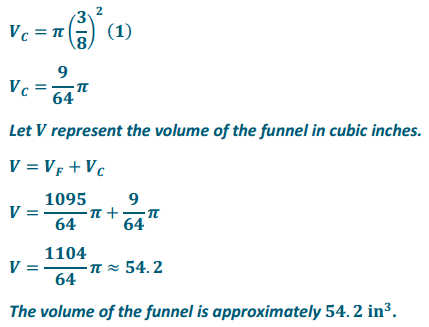
b. If 1 in3 is equivalent in volume to \(\frac{4}{231}\)qt., what is the volume of the funnel in quarts?
Answer:

The volume of the funnel is approximately 0.938 quarts.
c. If this particular grade of oil flows out of the funnel at a rate of 1.4 quarts per minute, how much time in minutes is needed to fill the 5. 2-quart container?
Answer:
Volume rate × time
Let t represent the time needed to fill the container in minutes.
5.2 = 1.4(t)
t = \(\frac{26}{7}\) ≈ 3.71
The container will fill in approximately 3.71 minutes (3 min. 43 sec.) at a flow rate of 1.4 quarts per minute.
d. Will the tank valve be shut off exactly when the container is full? Explain.
Answer:
If the tank valve is shut off at the same time that the container is full, the container will overflow because there is still oil in the funnel; therefore, the tank valve should be turned off before the container is filled.
e. How long after opening the tank valve should Jason shut the valve off?
Answer:
The valve can be turned off when the container has enough room left for the oil that remains in the funnel.
5.2 – \(\frac{23}{77}\)π ≈ 4.262
It is known that the flow rate out of the funnel is 1.4 quarts per minute.
Let t,, represent the time in minutes needed to fill the container and funnel with 5.2 quarts of oil.
Volume = rate × time
5.2 – \(\frac{23}{77}\)π = 1.4tp
tp ≈ 3.044
The container will ha ve enough room remaining for the oil left in the funnel at approximately 3.044 minutes; therefore, the valve on the bulk tank can also be shut off at 3.044 minutes.
f. What is the maximum constant rate of flow from the tank valve that will fill the container without overflowing either the container or the funnel?
Answer:
The flow of all from the bulk tank should just fill the funnel at 3.044 minutes, when the valve is shut off.
Volume = rate × time
Let r represent the rate of oil flow from the bulk tank in quarts per minute.
5.2 = r(3.044)
r ≈ 1.708
The flow of oil from the bulk tank can be at approximately 1.708 quarts per minute to fill the container without overflowing the container or the funnel used.
Eureka Math Geometry Module 3 Lesson 11 Exit Ticket Answer Key
Question 1.
Find the volume of the rectangular pyramid shown.
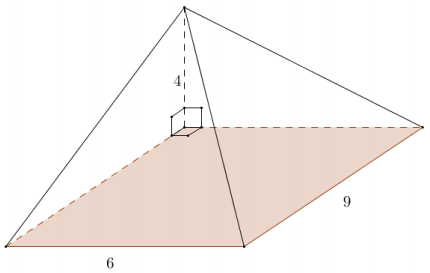
Answer:
Volume = \(\frac{1}{3}\)Bh
Volume = \(\frac{1}{3}\)(9 · 6) · 4
Volume = 72
The volume of the rectangular pyramid is 72 units.
Question 2.
The right circular cone shown has a base with radius of 7. The slant height of the cone’s lateral surface is √130. Find the volume of the cone.
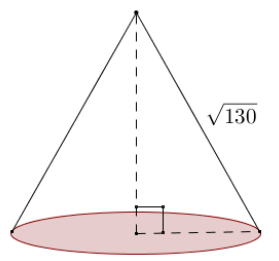
Answer:
The slant surface, the radius, and the altitude, h, of the cone form a right
triangle. Using the Pythagorean theorem,
h2 + 72 = (√130)2
h2 + 49 = 130
h2 = 81
h = 9
Volume = \(\frac{1}{3}\)Bh
Volume = \(\frac{1}{3}\)(π · 72) · 9
Volume = (49π) · 3
Volume = 147π
The volume of the right circular cone is 147π units3.
Eureka Math Geometry Module 3 Lesson 11 Exploratory Challenge Answer Key
Use the provided manipulatives to aid you in answering the questions below.
a.
i. What is the formula to find the area of a triangle?
Answer:
A = \(\frac{1}{2}\)bh
ii. Explain why the formula works.
Answer:
The formula works because the area of a triangle is half the area of a rectangle with the same base and same height.
b.
i. What is the formula to find the volume of a triangular prism?
Answer:
For base area B and height of prism h,
V = Bh.
ii. Explain why the formula works.
Answer:
A triangular prism is essentially a stack of congruent triangles. Taking the area of a triangle, repeatedly, is like multiplying by the height of the prism. Then, the volume of the prism would be the sum of the areas of all of the congruent triangles, which is the same as the area of one triangle multiplied by the height of the prism.
c.
i. What is the formula to find the volume of a cone or pyramid?
Answer:
For base area B and height of prism h,
V = \(\frac{1}{3}\)Bh.
ii. Explain why the formula works.
Answer:
Answers vary. Some students may recall seeing a demonstration in Grade 8 related to the number of cones (three) it took to equal the volume of a cylinder with the same base area and height, leading to an explanation of where the one-third came from.